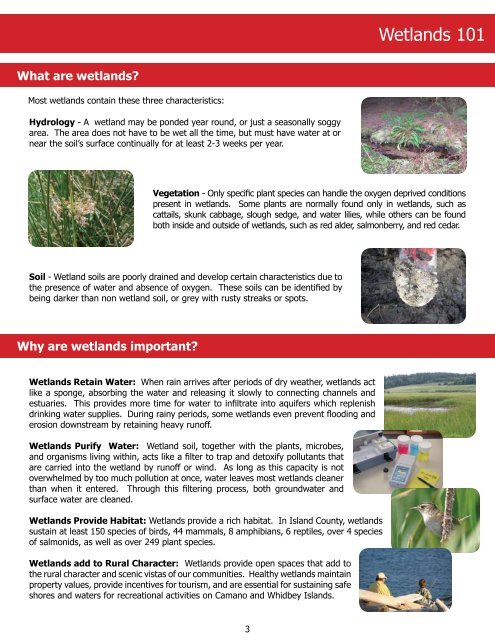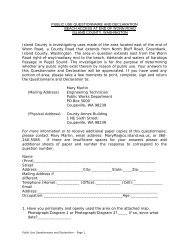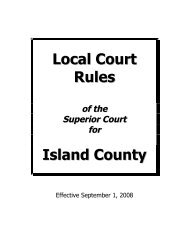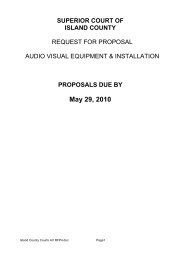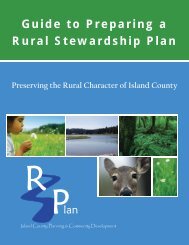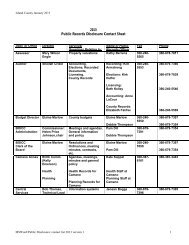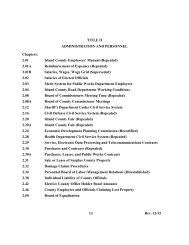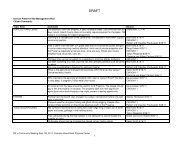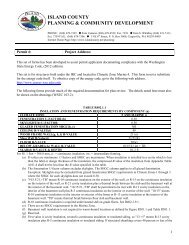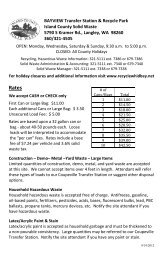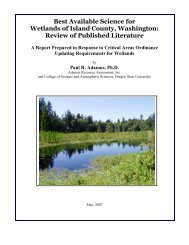Wetland I.D. Guide - Island County Government
Wetland I.D. Guide - Island County Government
Wetland I.D. Guide - Island County Government
You also want an ePaper? Increase the reach of your titles
YUMPU automatically turns print PDFs into web optimized ePapers that Google loves.
What are wetlands?<br />
Most wetlands contain these three characteristics:<br />
hydrology - A wetland may be ponded year round, or just a seasonally soggy<br />
area. The area does not have to be wet all the time, but must have water at or<br />
near the soil’s surface continually for at least 2-3 weeks per year.<br />
soil - <strong>Wetland</strong> soils are poorly drained and develop certain characteristics due to<br />
the presence of water and absence of oxygen. These soils can be identified by<br />
being darker than non wetland soil, or grey with rusty streaks or spots.<br />
Why are wetlands important?<br />
<strong>Wetland</strong>s 101<br />
Vegetation - Only specific plant species can handle the oxygen deprived conditions<br />
present in wetlands. Some plants are normally found only in wetlands, such as<br />
cattails, skunk cabbage, slough sedge, and water lilies, while others can be found<br />
both inside and outside of wetlands, such as red alder, salmonberry, and red cedar.<br />
<strong>Wetland</strong>s Retain Water: When rain arrives after periods of dry weather, wetlands act<br />
like a sponge, absorbing the water and releasing it slowly to connecting channels and<br />
estuaries. This provides more time for water to infiltrate into aquifers which replenish<br />
drinking water supplies. During rainy periods, some wetlands even prevent flooding and<br />
erosion downstream by retaining heavy runoff.<br />
<strong>Wetland</strong>s purify Water: <strong>Wetland</strong> soil, together with the plants, microbes,<br />
and organisms living within, acts like a filter to trap and detoxify pollutants that<br />
are carried into the wetland by runoff or wind. As long as this capacity is not<br />
overwhelmed by too much pollution at once, water leaves most wetlands cleaner<br />
than when it entered. Through this filtering process, both groundwater and<br />
surface water are cleaned.<br />
<strong>Wetland</strong>s provide habitat: <strong>Wetland</strong>s provide a rich habitat. In <strong>Island</strong> <strong>County</strong>, wetlands<br />
sustain at least 150 species of birds, 44 mammals, 8 amphibians, 6 reptiles, over 4 species<br />
of salmonids, as well as over 249 plant species.<br />
<strong>Wetland</strong>s add to Rural character: <strong>Wetland</strong>s provide open spaces that add to<br />
the rural character and scenic vistas of our communities. Healthy wetlands maintain<br />
property values, provide incentives for tourism, and are essential for sustaining safe<br />
shores and waters for recreational activities on Camano and Whidbey <strong>Island</strong>s.<br />
3


